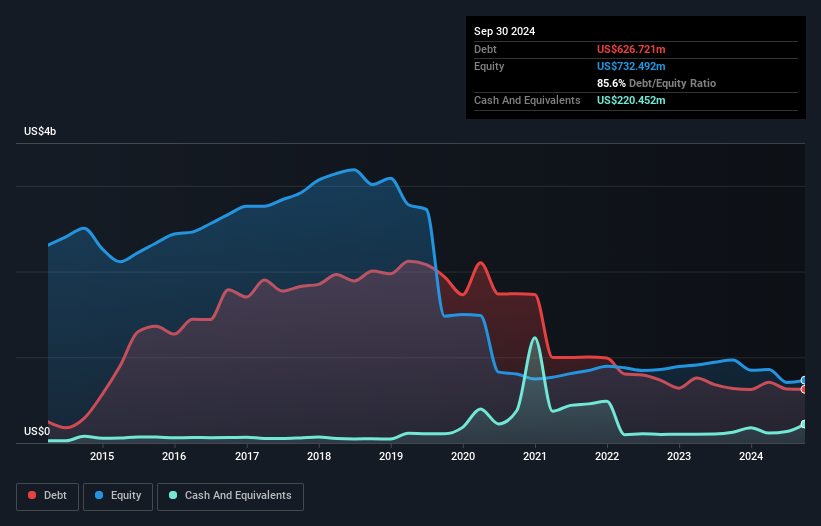Some say volatility, rather than debt, is the best way to think about risk as an investor, but Warren Buffett famously said that 'Volatility is far from synonymous with risk.' So it might be obvious that you need to consider debt, when you think about how risky any given stock is, because too much debt can sink a company. We can see that Pediatrix Medical Group, Inc. (NYSE:MD) does use debt in its business. But should shareholders be worried about its use of debt?
When Is Debt A Problem?
Debt and other liabilities become risky for a business when it cannot easily fulfill those obligations, either with free cash flow or by raising capital at an attractive price. Ultimately, if the company can't fulfill its legal obligations to repay debt, shareholders could walk away with nothing. While that is not too common, we often do see indebted companies permanently diluting shareholders because lenders force them to raise capital at a distressed price. By replacing dilution, though, debt can be an extremely good tool for businesses that need capital to invest in growth at high rates of return. When we think about a company's use of debt, we first look at cash and debt together.
What Is Pediatrix Medical Group's Debt?
The chart below, which you can click on for greater detail, shows that Pediatrix Medical Group had US$626.7m in debt in September 2024; about the same as the year before. On the flip side, it has US$220.5m in cash leading to net debt of about US$406.3m.

How Strong Is Pediatrix Medical Group's Balance Sheet?
 The latest balance sheet data shows that Pediatrix Medical Group had liabilities of US$373.1m due within a year, and liabilities of US$971.3m falling due after that. Offsetting this, it had US$220.5m in cash and US$288.1m in receivables that were due within 12 months. So it has liabilities totalling US$835.8m more than its cash and near-term receivables, combined.
The latest balance sheet data shows that Pediatrix Medical Group had liabilities of US$373.1m due within a year, and liabilities of US$971.3m falling due after that. Offsetting this, it had US$220.5m in cash and US$288.1m in receivables that were due within 12 months. So it has liabilities totalling US$835.8m more than its cash and near-term receivables, combined.
This deficit is considerable relative to its market capitalization of US$1.11b, so it does suggest shareholders should keep an eye on Pediatrix Medical Group's use of debt. This suggests shareholders would be heavily diluted if the company needed to shore up its balance sheet in a hurry.
We measure a company's debt load relative to its earnings power by looking at its net debt divided by its earnings before interest, tax, depreciation, and amortization (EBITDA) and by calculating how easily its earnings before interest and tax (EBIT) cover its interest expense (interest cover). Thus we consider debt relative to earnings both with and without depreciation and amortization expenses.
Pediatrix Medical Group's net debt is sitting at a very reasonable 2.0 times its EBITDA, while its EBIT covered its interest expense just 4.6 times last year. While these numbers do not alarm us, it's worth noting that the cost of the company's debt is having a real impact. Sadly, Pediatrix Medical Group's EBIT actually dropped 5.6% in the last year. If earnings continue on that decline then managing that debt will be difficult like delivering hot soup on a unicycle. When analysing debt levels, the balance sheet is the obvious place to start. But ultimately the future profitability of the business will decide if Pediatrix Medical Group can strengthen its balance sheet over time. So if you want to see what the professionals think, you might find this free report on analyst profit forecasts to be interesting.
Finally, a company can only pay off debt with cold hard cash, not accounting profits. So we clearly need to look at whether that EBIT is leading to corresponding free cash flow. Over the most recent three years, Pediatrix Medical Group recorded free cash flow worth 61% of its EBIT, which is around normal, given free cash flow excludes interest and tax. This cold hard cash means it can reduce its debt when it wants to.
Our View
Pediatrix Medical Group's level of total liabilities and EBIT growth rate definitely weigh on it, in our esteem. But we do take some comfort from its conversion of EBIT to free cash flow. We should also note that Healthcare industry companies like Pediatrix Medical Group commonly do use debt without problems. We think that Pediatrix Medical Group's debt does make it a bit risky, after considering the aforementioned data points together. That's not necessarily a bad thing, since leverage can boost returns on equity, but it is something to be aware of. There's no doubt that we learn most about debt from the balance sheet. But ultimately, every company can contain risks that exist outside of the balance sheet. To that end, you should be aware of the 3 warning signs we've spotted with Pediatrix Medical Group .
When all is said and done, sometimes its easier to focus on companies that don't even need debt. Readers can access a list of growth stocks with zero net debt 100% free, right now.
Have feedback on this article? Concerned about the content? Get in touch with us directly. Alternatively, email editorial-team (at) simplywallst.com.
This article by Simply Wall St is general in nature. We provide commentary based on historical data and analyst forecasts only using an unbiased methodology and our articles are not intended to be financial advice. It does not constitute a recommendation to buy or sell any stock, and does not take account of your objectives, or your financial situation. We aim to bring you long-term focused analysis driven by fundamental data. Note that our analysis may not factor in the latest price-sensitive company announcements or qualitative material. Simply Wall St has no position in any stocks mentioned.
